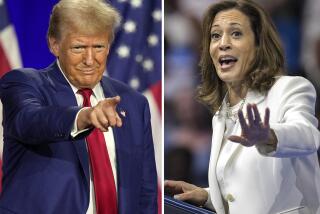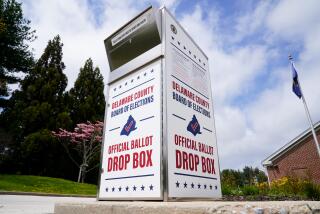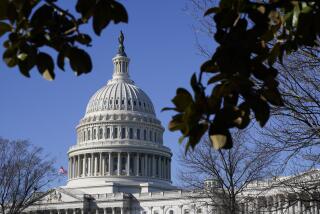Health Care Firms Spend Big to Head Off Reforms
- Share via
With billions of dollars in profits on the line, the health care industry is waging the largest national advertising campaign ever conducted by a political special interest, with a price tag for the election cycle that could approach $90 million--more than either of the major presidential candidates is expected to spend.
Already, leading pharmaceutical makers have spent about $34 million on television, radio and print ads since last July, making them the biggest exploiter of a just-closed loophole that allowed donors to remain anonymous while funding political ad campaigns.
But only part of the staggering sums are being paid by drug makers, who are fighting a plan to expand Medicare by adding prescription drug coverage. Managed care companies opposed to proposed regulations such as a right for patients to sue are also pouring cash into commercials.
“You’re going to have the biggest ad blitz on health care America has ever seen,” said Mark Merritt, a strategist for the American Assn. of Health Plans, which is broadcasting some of the ads. By November, he said, the waves of ads will mean “the most educated electorate on health care in modern history.”
The commercials make no specific reference to the candidates seeking the White House. But they attack some White House policies that are supported by Vice President Al Gore, the presumptive Democratic nominee, and opposed by Texas Gov. George W. Bush, his Republican rival.
One series of ads critical of White House plans to add prescription drug coverage to Medicare features “Flo,” a senior citizen in a women’s bowling group who rejects the intrusion of “bureaucrats” in her medicine cabinet.
Another commercial in March seeking to block legislation that would allow patients to sue their health maintenance organization for medical malpractice includes scenes of doctors working with a text that reads: “Washington prefers more lawsuits. But lawsuits don’t save lives. Doctors do. Get patients the care they need instead of getting lawyers the clients they want.”
Key Congressional Races Targeted
The commercials are being funded largely by companies that learned the political ropes when they organized against President Clinton’s highly touted health care overhaul, which was scuttled in 1994.
Although the ads do not refer specifically to the presidential campaign, the pharmaceutical industry has focused on key congressional races, airing commercials in the districts of at least four House Democrats who backed a bill containing the Medicare drug coverage plan. The ads accuse them of “playing politics” with the issue.
Gore campaign officials said they are also concerned about commercials that are critical of the vice president’s health care positions, even if they do not refer to him by name.
“They’re going to win some votes on this thing,” a Gore advisor said, referring to the prescription drug commercials. “When you put $50 million on the air, it’s going to have its desired effect.”
Although some independent experts agree the spots will help Bush, others suggest the industry blitz could backfire by raising the profile of an issue on which public opinion is on Gore’s side.
“The more the [ad] campaign focuses on this issue, the more Al Gore wins support,” said Ron Pollack, executive director of Families USA, a nonpartisan consumer group in Washington.
Gore recently singled out this year’s biggest health care advertiser, Citizens for Better Medicare, a pharmaceutical industry-funded group responsible for about two-thirds of this year’s health-related advertising. Gore called it a “phony coalition” sponsored by the drug companies who fear Medicare-backed prescription drug coverage would erode their profits.
The vice president complained that CBM was hiding its donors under a controversial provision in the tax code, Section 527, which was recently closed in the only campaign finance reform bill to pass Congress this year. The provision let groups raise unlimited sums without identifying their donors.
Most Donors Come From the Industry
Dan Zielinski, a spokesman for the organization, noted that it has listed its membership, which includes many of its donors, “from day one” online. He also said “almost all” of the donors are from the pharmaceutical industry. But he declined to reveal CBM’s complete list of donors, how much they contributed or how much cash the organization has for the campaign.
Zielinski said critics who attack the group’s lack of disclosure are “vilifying the messenger instead of discussing the policy” questions involved. He also insisted the group is not trying to influence political races.
“Our sole concern is to educate the public [and] counter misinformation,” he said. “We are not interested in the political and electoral races.”
But Democrats are already suspicious because the company that places the commercials for Citizens for Better Medicare--National Media, an Alexandria, Va., firm--also does the same for the Republican National Committee. Many of the CBM ads are also being broadcast in the same markets as GOP ads, including those in Midwest battleground states.
When the RNC temporarily suspended its television ads earlier this month, Democrats say that CBM increased its advertising buys. The GOP resumed its television campaign this week.
The ads featuring “Flo”--broadcast by CBM--recall the health insurance industry’s famed “Harry and Louise” ads, in which a fictional middle-class couple sat at the kitchen table berating Clinton’s 1994 health care overhaul proposals.
At the time, jaws dropped in Washington over that ad campaign’s estimated $14-million price tag, which was picked up by the Health Insurance Assn. of America. Now, with far more money to flood the airwaves, major corporations are testing the tactic again.
Democrats and industry experts expect CBM will have spent $65 million by November. An analysis by the Campaign Media Analysis Group, a Virginia-based firm that tracks political advertising for The Times, shows CBM has spent about $34 million since last summer. Researchers at the University of Pennsylvania’s Annenberg Public Policy Center say the airwaves this year also are awash with ads from at least six other health care groups that had spent or committed to spending about $25 million on political commercials.
Health care industry spending could surpass the ad budgets of either presidential campaign. Bush has spent about $22.3 million on ads from early 1999 to the end of May of this year, according to the Campaign Study Group, a Virginia-based organization that tracks campaign finances for The Times. Gore has spent about $10.8 million over the same period. Each candidate is expected to spend about $40 million on ads in the general election.
By commercial advertising standards, the health care groups’ political ad blitz is big, but not overwhelming. The pharmaceutical group’s spending is roughly comparable to the marketing budget of a summer blockbuster movie such as “Mission Impossible 2.”
Still, the millions being shelled out are “small compared to the amount of money that’s at stake” in November, said Princeton health economist Uwe Reinhardt.
For the HMOs, many of which are barely profitable, and the pharmaceutical firms, whose profits are among the highest in American industry, bombarding the airwaves is good business, he said.
“The rate of return would be stunning if you hold off [stricter regulation] for another three to four years,” said Reinhardt. “It would be a fine investment . . . and of course the TV industry will laugh all the way to the bank.”
Elderly people without prescription drug coverage make up one of the most profitable segments of the $100-billion-a-year U.S. drug market because they pay retail prices for their medicine with cash up front.
The presidential candidates’ competing plans could have markedly different effects on that market. The federal government’s Medicare program, which helps pay for health care for 39 million elderly and disabled Americans, has never covered prescriptions.
Gore, like Clinton, is pushing a plan to have the government cover 50% of Medicare recipients’ drug costs up to $5,000 and the full cost of drugs for people with very high out-of-pocket costs. Bush would overhaul Medicare and have private insurers offer a range of coverage, some with drug coverage.
State Reforms Already Pending
Major drug firms are already concerned because bills to mandate drug discounts are pending in 18 states.
Nerves are also frazzled among HMO executives, who are seeing accelerating momentum for expanding patient rights. Both major party candidates back legislation prohibiting HMOs from making patients obtain prior permission to visit an emergency room, for example. HMOs try to limit access to emergency and specialist services because they cost the companies more.
Bush signed a patient protection bill as governor of Texas and said he would expand its provisions to cover people in federally governed health plans. He also said he would support a limited right for patients to sue their HMOs in some cases.
Gore supports a more expansive plan that would guarantee consumers many of the same rights, including an independent vetting of HMO-related complaints. His plan is more expansive, however, covering people in all health plans.
“We’re talking about no less than the final destruction of managed care,” Reinhardt said. And with pharmaceutical companies wary of government plans that might lead to price controls, “they fear the government like the plague.”
More to Read
Get the L.A. Times Politics newsletter
Deeply reported insights into legislation, politics and policy from Sacramento, Washington and beyond. In your inbox three times per week.
You may occasionally receive promotional content from the Los Angeles Times.










